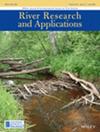How low is too low? Partnering with stakeholders and managers to define ecologically based low‐flow thresholds in a perennial temperate river
IF 1.9
4区 环境科学与生态学
Q4 ENVIRONMENTAL SCIENCES
引用次数: 0
Abstract
Managing aquatic ecosystems for people and nature can be improved by collaboration among scientists, managers, decision‐makers, and other stakeholders. Many collaborative and interdisciplinary approaches have been developed to address the management of freshwater ecosystems; however, there are still barriers to overcome. We worked as part of a regional stakeholder group comprising municipal water utility operators, conservation organizations, academic partners, and other stakeholders to understand the effects of low‐flow and drought on ecological functions of the upper Flint River, Georgia (USA), a free‐flowing river important for municipal water supply, recreation, and native biota. We used published literature and locally targeted studies to identify quantitative flow targets that could be used to inform water management and drought planning. Drawing from principles of Translational Ecology, we relied on an iterative process to develop information needs for the group and maintained communication and engagement throughout data collection, analysis, and synthesis. We identified three quantitative flow benchmarks to evaluate the ecological impacts of drought in the river. The results were valuable to both the water utilities represented in the working group and State regional water planning, which is used to guide water management strategies and permitting for the basin. We identified principles that were important for the successful engagement in the working group and helped to overcome the challenge of working across sectors and without direct authority guiding the implementation of our work. Interdisciplinary work and creative solutions are crucial to plan for and adapt to greater pressure on our water resources.多低才算低?与利益相关者和管理者合作,在一条多年生温带河流中确定基于生态的低流量阈值
通过科学家、管理者、决策者和其他利益相关者之间的合作,可以更好地为人类和自然管理水生生态系统。为解决淡水生态系统的管理问题,已经开发了许多跨学科的合作方法;但是,仍有许多障碍需要克服。我们作为地区利益相关者团体的一员,该团体由市政水务运营商、保护组织、学术合作伙伴和其他利益相关者组成,旨在了解低流量和干旱对佐治亚州弗林特河上游生态功能的影响。我们利用已发表的文献和针对当地的研究来确定定量流量目标,以便为水资源管理和干旱规划提供信息。借鉴 "转化生态学 "的原则,我们采用迭代流程为小组开发信息需求,并在整个数据收集、分析和综合过程中保持沟通和参与。我们确定了三个定量流量基准,以评估干旱对河流生态的影响。这些结果对工作组中的水务公司和州区域水规划都很有价值,州区域水规划用于指导流域的水管理策略和许可。我们确定了对成功参与工作组工作非常重要的原则,这些原则有助于克服跨部门工作的挑战,也有助于在没有直接权力指导工作实施的情况下开展工作。跨学科工作和创造性解决方案对于规划和适应水资源面临的更大压力至关重要。
本文章由计算机程序翻译,如有差异,请以英文原文为准。
求助全文
约1分钟内获得全文
求助全文
来源期刊

River Research and Applications
环境科学-环境科学
CiteScore
4.60
自引率
9.10%
发文量
158
审稿时长
6 months
期刊介绍:
River Research and Applications , previously published as Regulated Rivers: Research and Management (1987-2001), is an international journal dedicated to the promotion of basic and applied scientific research on rivers. The journal publishes original scientific and technical papers on biological, ecological, geomorphological, hydrological, engineering and geographical aspects related to rivers in both the developed and developing world. Papers showing how basic studies and new science can be of use in applied problems associated with river management, regulation and restoration are encouraged as is interdisciplinary research concerned directly or indirectly with river management problems.
 求助内容:
求助内容: 应助结果提醒方式:
应助结果提醒方式:


